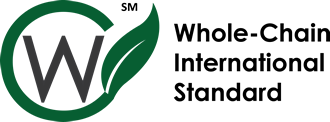Whole-Chain International Standard Certification

WHOLE-CHAIN CERTIFICATION
We certify businesses that lead the way in ensuring full transparency and authenticity across their supply chains. Our certification highlights organizations that implement cutting-edge technologies and processes to track products from source to consumer, ensuring ethical sourcing, quality assurance, and responsible practices. With our certification, you can demonstrate your commitment to innovation that builds trust, enhances transparency, and delivers genuine value to your customers and stakeholders.
We are committed to empowering the future of the food industry.
Register Organization
WHOLE-CHAIN CERTIFICATION PROCESS
Step 1
To begin the journey towards compliance with the Whole-Chain International Standard, organizations must first register. This process involves providing basic information about your business, its supply chain, and the sustainability practices you aim to enhance.
Implement Standard
Step 2
Implementing the Whole-Chain International Standard involves applying key procedures across your organization. This ensures that you are compliant with supply chain, sustainability, and transparency requirements, driving operational efficiency and risk mitigation.
Collect Data
Step 3
Collecting accurate data is essential for tracking your performance under the Whole-Chain International Standard. Key Performance Indicators (KPIs) must be measured to ensure compliance and identify areas for improvement.
Demonstrate Compliance
Step 4
Demonstrating compliance with the Whole-Chain International Standard is crucial to prove that your organization meets all requirements regarding sustainability, risk management, and supply chain transparency. This is typically achieved through regular audits, KPI tracking, and documentation to ensure that your organization is continually aligned with the standard.
Obtain Certification
Step 5
Obtaining certification for the Whole-Chain International Standard validates your organization’s commitment to sustainability, transparency, and ethical supply chain practices. Certification is achieved through a third-party audit and ongoing adherence to the standard.
Questions
FAQ
If you still have questions, please contact us by completing the form underneath.
The registration process for the Whole-Chain International Standard typically begins with contacting us or the Institute of Innovation and Advanced Learning – the schema owner that oversees the standard. Your organization will need to provide details about its operations, supply chain, and sustainability efforts. Once the initial information is reviewed, a registration application will be submitted, followed by an audit schedule for assessing your organization’s readiness for certification. This is an important first step to demonstrate your commitment to transparency, sustainability, and compliance with the standard.
The implementation timeline can vary depending on the size of the organization and the complexity of its supply chain. For example, in a streamlined implementation, it may be possible to implement the standard within a focused period, such as 4 days, if there is a dedicated team of consultants working on procedure development, KPI establishment, and system integration. However, the process could take longer for larger or more complex organizations. It involves implementing procedures, developing KPIs, collecting data, and training personnel.
To comply with the Whole-Chain International Standard, the following procedures are typically implemented:
- Governance and Leadership
- Sustainability Integration
- Supply Chain Transparency
- Risk and Compliance Management
- Data Security and Privacy
- Customer Communication and Transparency (Customer Access, Returns, and Recalls)
- Continuous Improvement and Auditing
- Innovation and Collaboration
- Training and Employee Engagement
Each procedure ensures compliance with various aspects of supply chain management, sustainability, risk mitigation, and transparency.
Compliance with the Whole-Chain International Standard is demonstrated through a combination of implementing specific procedures and measuring performance with Key Performance Indicators (KPIs).
Key Performance Indicators (KPIs) are crucial for measuring compliance and performance in relation to the Whole-Chain International Standard.
To obtain certification for the Whole-Chain International Standard, the process generally involves the following steps:
- Registration: Submit an application through our website.
- Pre-Audit or Gap Analysis: Assess the current state of your operations compared to the requirements of the standard.
- Standard Implementation: Implement the required procedures across your organization.
- KPI Establishment: Develop and assign KPIs to measure performance and compliance.
- Internal Audits: Conduct internal audits to ensure readiness for certification.
- Certification Audit: A third-party auditor will conduct an independent audit to verify compliance with the Whole-Chain Standard.
- Certification Issuance: Once the audit is successfully completed and all requirements are met, we will issue your certification.
Once your organization is certified, audits will typically occur annually to ensure ongoing compliance with the Whole-Chain International Standard. In some cases, there may be additional surveillance audits during the certification cycle to confirm that conformance is being maintained. Continuous improvement through regular audits is essential to maintain certification status and to address any areas of non-compliance promptly.
Employees will need training on specific procedures related to the Whole-Chain Standard, depending on their role within the organization. This includes:
- Governance and Leadership: Training on diversity and leadership procedures.
- Sustainability Integration: Awareness of sustainable sourcing practices and environmental impact.
- Supply Chain Transparency: Understanding of traceability systems and transparency in the supply chain.
- Data Security and Privacy: Knowledge of data protection protocols and privacy regulations.
- Risk and Compliance: Training on risk mitigation strategies and regulatory compliance.
Each department may require specific training relevant to their function in order to ensure the procedures are correctly followed and the KPIs are accurately tracked.
If non-compliance issues are identified during an audit, your organization will need to develop a corrective action plan. This plan should include:
- Root Cause Analysis: Identify the underlying cause of the non-compliance.
- Corrective Actions: Implement specific steps to address the issue and prevent recurrence.
- Follow-Up Audits: Conduct a follow-up audit to ensure that the corrective actions have been effectively implemented and that the issue has been resolved.
Documentation of corrective actions is key to demonstrating that your organization is committed to maintaining compliance with the Whole-Chain International Standard.
The cost of the certification varies across organizations. We take into consideration, the size of the organization, the number of employees, brands, product categories, and other factors that have an impact on the length of time to review and audit the processes that are particular to each organization.
